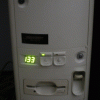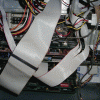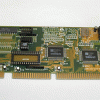Anonymous Coward wrote:I like your PIII system. When the powerleap tualatin adapter first came out I tried to take my Abit BF6 PIII system to it maximum potential. In theory it should have made a pretty good machine, but in reality my system became somewhat unstable. I just ended up selling the adapter and getting an i815 based motherboard instead. It is really too bad, because I liked the BX chipset much better. I guess perhaps as my powerleap adapter was the very first revision, it was a little buggy.
Does your system have any options to run the FSB at 133MHzÉ
My BF6 did, but the stupid AGP divider was always a problem. I should have just said screw it and used PCI instead. AGP 1X and 2X were highly overrated anyway.
Yes, it has actually. The manual shows jumper settings all the way up to a 150mhz FSB.
I have never tried it (I don't have PC133 SDRAM laying around), but on the P2B the AGP speed will be a problem also.
There is only an option to run the AGP at 1:1 (yeah right!) or 2:3 of the FSB. That would surely break it.
The only problem I had with the PL-iP3/T is that Dell apparently has these in OEM form for their own systems and this includes a non standard ATX cable (!). For some reason their systems use exactly the same ATX plug, but the wiring is different.
I hooked it up and it didn't boot. Looked up the ATX pinout and was really glad nothing blew up when I saw how weird their pinout is compared to the standard ATX, haha!
I ended up making my own cable.
I also replaced the "Powerleap" fan with a Spire one that is more silent.
Silent Loon wrote:Great assembly indeed! […]
Show full quote
Great assembly indeed!
I wondered about the Terratec Gold 16/96 - do you use it for SoundblasterPro emulation?
I ask because I own such a card myself. As terratec cards mostly have a better sound quality, I wanted to use it to replace my SB16 Vibra card. But I got difficulties with an attached Roland daughterboard. It simply didn't work - no midi sound (in DOS 6.2) for what reason ever.
As you know, the Gold 16/96 is a pnp card, but I would suggest that your 486board isn't pnp, so you might use ESCFG.EXE to configure it. Does it work for you with a midi-daughterboard attached (i.e. with GM sound in games)? How?
Getting the terratec working with an attached midi board would be a great help for me, as this is one of the few "all-in-one" cards that would fit in my small case. ( my little Midi box )
Yes, you have grasped me perfectly.
The motherboard I use has an insane amount of 16-bit ISA slots (8x!) leaving me with one empty slot even with everything I want in there.
I thought of two options:
1) Put in a SB Pro 2 I have laying around.
This would give me a big headache, because the SB Pro is fully jumpered. I would have to use seriously unorthodox settings to have it run in such a full case without conflict making it pretty much unusable.
I could solder switches to the jumpers, but then still it would be a headache. It would mean making different startup configurations for the SB Pro and SB16 and switches connected to the SB16 jumpers to basically switch their ports around.
I can't even remember any SB Pro only games I want to play.
So...
2) Add the Terratec.
Not only is this card fully (100%!) software configurable and SB Pro compatible, it has a wavetable header also!
The choice was easily made.
I seriously didn't know it was a PnP card, haha! I thought it was just software configurable like the GUS MAX.
Have used a PnP IO card once and that was a nightmare on my non PnP system, so since this card works so perfectly I never considered it being PnP.
The DB-60XG daughterboard I have works perfectly on the 16/96. I did some experimenting to see if there were differences running it on the SB-16 or 16/96 and it never gave me problems.
What I do is simpy run ESCFG and enable the MPU and choose a MIDI port (330h).
You say it doesn't work in DOS (I run it only DOS btw), it does work in Windows? Do other MIDI solutions work on the same port in the same system?
Amigaz wrote:
Hehe.


